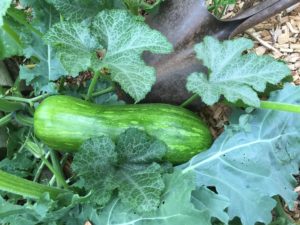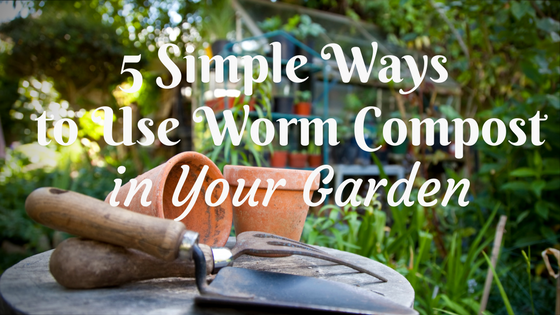A trowel and clippers are just two of the invaluable tools used to reveal a gardener’s paradise. Hours of labor and painstaking attention to detail transform a dormant winter garden into a lush and humming cacophony of life once the weather warms.
But did you know that vibrant life above ground is made strongest not by the hands of the gardener, but by the billions of microbes and micronutrients in the soil beneath!? It’s true! That means, generally, if you have healthy soil, you’ll have healthy plants too.
The amazing thing is, we worm farmers have direct access to the key players in the underground world. Our red wigglers are an invaluable tool in boosting our garden’s beauty quotient. They are the immediate source of the very best natural fertilizer on earth!
Worm Casts: Nature’s Power Pellets
The particles of food a red wiggler consume become a nutrient-rich cast packed with all of the essential ingredients for plants of all types to grow to their full potential. In fact, according to the USDA, casts are 5 to 11 times richer in available nitrogen, phosphorus, calcium, and magnesium than the organic matter the worm eat to make it. That sounds to me like the very best upcycling possible!
When used as fertilizer, worm castings slowly release a perfectly balanced blend of nutrients that can stimulate growth and healing, increase flower and fruit production. What’s more, worm compost even helps to fend off disease! This stuff is mega, so, a little goes a long way!
Not only that, but finished vermicompost has all of the properties of a humus soil, one that retains water while still allowing for proper drainage and gaps for oxygen. This becomes the ideal environment for strong root growth and the way each plant absorbs the building blocks for growth. Worm compost is the $#!@- Pun totally intended!
The Ways and Means
I’ve seen it happen- if you feed the soil, the soil feeds you.
It’s been my experience that even a scant sprinkling of vermicompost at the base of tired tomatoes offers noticeably significant improvement in plant vigor. And when used for transplants there seems to be greatly reduced shock and a far superior rate of survival compared to those without any special treatment.
I am so excited to share 5 ways worm compost can be used to get the very best out of anything you grow- whether in your home, on your porch, or in your garden. Try any of these methods to safely and naturally urge your plants into their prime for months at a time.
1) Top Dressing
As the name implies, top dressing refers to the application of worm compost right on top of the soil. Again, it doesn’t take much at all. Just a sprinkling over the area of the root mass will eventually filter down and feed the plant. This is the easiest way to incorporate vermicompost as it requires no measuring or mixing.
Sometimes you’ll see this method by the name of side dressing as well. The concept is the same. Every few months a gardener offers a scant handful of vermicompost at the base of the plant. Every time it rains, or little creatures carry a tiny bit of cast down into the soil, your plant will have a special delivery of vitamins and minerals.
2) Soil Amendment
Unlike top dressing, amending your soil with vermicompost is done before the plant is set into place. In this case, you would mix potting soil or garden soil with the compost so that it is even throughout and surrounds the roots once they extend into the earth.
This application requires more compost to start with but enhances the overall structure of the soil in addition to offering nutrition. This is my favorite way to ensure any special ornamentals or favorite heirloom varieties get the TLC that will help them get well established and conquer environmental stress.
3) Seed Starter
Any gardener who takes the time to nurture plants up from seed knows they require a tender touch, perfect sun exposure, water, and nutrients to grow past that first stage. But, by incorporating a healthy dose of vermicompost in proportion to the rest of your seed starting mix you give that little seedling an even better chance at not only surviving but thriving.
It has been shown time and again, as evidenced here in a report out of South Carolina State University, that germination and seedling growth is improved by planting in worm castings. According to research out of Cornell University,” Department of Plant Pathology and Plant-Microbe Biology, Ph.D. student Allison Jack has shown that beneficial microbes in vermicompost can colonize a seed’s surface and protect it from infection by releasing a substance that interferes with the chemical signaling between the host and the pathogen.”
Make your own seed starting mix then see how easy it is to start seeds of your own. You can even use the same mix with tender cuttings you’d like to take root as well.
4) Liquid Fertilizer (Compost Tea)
The name is deceptive when at first you think of chamomile or the like, but compost tea is made by steeping finished vermicompost rather than tea leaves. Over time, beneficial microbes multiply in the water creating a tonic that both quickly delivers nutrients directly to the roots, but can also be sprayed ON the plants as a protection from such things as airborne diseases, and infestation.
Brewing Tea
Making a liquid fertilizer can be as simple as dumping a scoop of compost in a watering can and letting it sit overnight, or as complicated as using a system that will aerate the tea over many days with an added food source to feed a rapidly increasing population of microorganisms in the tea. The measurements needn’t be specific but you can aim for about a cup of compost per gallon of water to start.
If you are wondering which is better, I can just say that the second is a “richer” food source but takes more materials, time, and effort. I know how resourceful we worm farming gardener types are- I have all the faith in the world that you’ll find variations on this theme that will work perfectly in your garden and have the results to show for it!
The Strawberry Store demonstrates in an easy to follow tutorial just how to brew and use compost tea at home. Bently, from Red Worm Composting, points out something worth paying close attention to, warning, “be very careful with non-aerated teas though, especially with potted plants. Various compounds created via anaerobic processes can be phytotoxic (harmful to plants).”
Keep in mind that compost tea is entirely different than the leachate that seeps out of a very wet worm bin. Leachate can be used if well diluted and fed to hardy plants but may contain certain compounds that may be damaging to others. Use caution and avoid using leachate directly on foliage.
5) Turf Builder
The final application I want to share is for all of us struggling to keep our lawns consistently green, lush, and weed free. I won’t promise that using worm compost will kill weeds, but what it will do is help get your grass into top shape.
Vermicompost fertilizer will encourage your lawn to have deep strong roots that can take in the water and nutrients needed to grow grass that inhibits the growth of weeds. A lawn fed with a naturally balanced fertilizer will be vibrant and green, need less frequent watering, and will bounce back more quickly after the dry and cold seasons.
Simply broadcast relatively dry castings using a seed spreader so that the bits can fall down between the blades of grass. Rain will allow the particles to slowly be released into the earth and feed your lawn for months at a time.
Vermicompost: the Gift that Keeps on Giving
It’s clear that black gold worm compost is nothing less than a treasure for those who use it to grow healthy produce, jaw-dropping landscape plants, or even stellar houseplants. But there’s one more way finished compost goes even further to support life-giving soil.
*Bonus
Pull out all the stops, and mix finished vermicompost into a pile of tired and depleted soil mixed with organic materials such as mulched leaves to breathe new life into it once again. In a matter of weeks, the microbes within will have repopulated the soil, begun to break down the leaf matter, and reestablished the soil and compost mixture as a valuable resource. Continue to add organic material and turn this new soil frequently to aerate and allow for optimal composting conditions.
Worm Compost vs. Fertilizer
Worm compost is a living thing. Seen under a microscope one could find a flurry of microbes hard at work digesting organic materials and releasing byproducts. The perfect natural balance of nutrients released in the gut of the red wiggler creates a safe product that doesn’t “burn” plants like commercial fertilizers can.
Every bit of vermicompost is water soluble and therefore available as food for the plants. Not an ounce is wasted- how is that for sustainability!?
Furthermore, in the long run, the cost of producing worm compost is near to nothing in comparison to what it takes to manufacture store bought fertilizers. With zero waste or negative environmental impact- worm compost in the garden is very much worth considering.
Now you have a handful of excellent ways to use your valuable worm compost to fertilize your plants and improve your soil. Join a host of others changing the landscape of their lives through worm composting. Sign up for The Squirm Firm monthly newsletter. Once each month you’ll receive FREE access to the tips, tricks, and information you need to become a worm composting expert!


What to do with the compost over the winter? Is there a way to store it until the beginning of growing season? or should I just spread over the area where my garden is and it will do “it’s thing” next growing season? I live in RI so we are starting to get cooler weather here now and my gardens are winding down….
I use the Worm Factory 360 and keep it indoors in my kitchen in Indiana. I try to empty all bin batches sometime in the Fall, so that I’m essentially starting over for winter with 4 bins full of shredded cardboard. By Spring, I’m ready to dump at least the first 2 bins into the garden, and the last 2 bins in early Summer. I try to rotate bins out again in the Fall, so I have 3 to 4 bins to work with over the long winter. I’ve been doing this for at least 5 years. Hope this idea helps.
Impressed by vermicompost for plants.
Vermicompost is natures most bioavailable and nutrient-rich fertilizer! I hope you get to use it in your own garden!
nice information
Very enlightening! Thanks for your pro tips
This is good.
But I’ve got a question.
What if you apply vermicompost in your garden in the morning and it rains heavily by mid day. Is there not going to be a wash up of all that was applied? Could this be a possible limitation of using vermicompost?
Thank you for your very logical question. The best way to use your vermicompost would be to mix it into or under existing soil. Sun exposure, wind, and rain can be really powerful. Sun parches, wind dries and blows things away, and rain can flood gardens out. However, with your compost turned into the soil rain is unlikely to wash anything away. Excellent drainage ensures water won’t run, rather, it will seep down into the soil, enriching and delivering nutrients all along the way.
Excellent article. Nice warning on worm farm leachate. It’s commonly misunderstood with worm tea / worm wee.
What is the most efficient way to remove your worms from the compost before you utilize the castings?
Oh, harvesting! So much fun! There are a number of ways. None of them are particularly fast but you can enjoy the process if you can be patient. So, there’s the light method in which you scoop away the compost worms have fled from because of light. Or you can use a sort of tumbler for compost that lets the little bits fall through as it tumbles. Or you can expose your compost to air and let it get dry- so dry that the worms crawl somewhere else- and you take what’s dry. OR you can use my favorite which utilizes a tray from a tray-style composter and simply sift the compost through the holes into a big storage bin. From there, I pick out the cocoons and any worms that have fallen through. I won’t say those are the only ways. Creativity wins!
I’m wondering about using worm tea as a fertilizer for hydroponics. If I just want the nutrients from the tea and not the microbes, can it be sterilized and retain good nutrient levels?